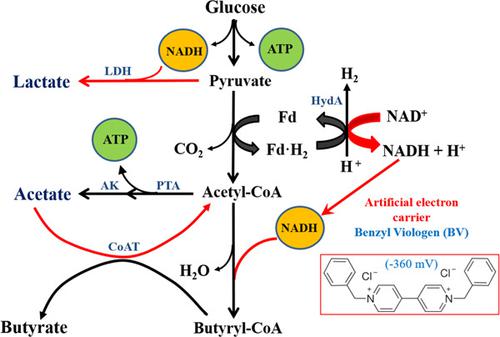当前位置:
X-MOL 学术
›
Biotechnol. Bioeng.
›
论文详情
Our official English website, www.x-mol.net, welcomes your feedback! (Note: you will need to create a separate account there.)
Effects of benzyl viologen on increasing NADH availability, acetate assimilation, and butyric acid production by Clostridium tyrobutyricum
Biotechnology and Bioengineering ( IF 3.8 ) Pub Date : 2020-10-15 , DOI: 10.1002/bit.27602 Hongxin Fu 1, 2 , Meng Lin 2 , I-Ching Tang 3 , Jufang Wang 1 , Shang-Tian Yang 2
Biotechnology and Bioengineering ( IF 3.8 ) Pub Date : 2020-10-15 , DOI: 10.1002/bit.27602 Hongxin Fu 1, 2 , Meng Lin 2 , I-Ching Tang 3 , Jufang Wang 1 , Shang-Tian Yang 2
Affiliation

|
Clostridium tyrobutyricum produces butyric and acetic acids from glucose. The butyric acid yield and selectivity in the fermentation depend on NADH available for acetate reassimilation to butyric acid. In this study, benzyl viologen (BV), an artificial electron carrier that inhibits hydrogen production, was used to increase NADH availability and butyric acid production while eliminating acetic acid accumulation by facilitating its reassimilation. To better understand the mechanism of and find the optimum condition for BV effect on enhancing acetate assimilation and butyric acid production, BV at various concentrations and addition times during the fermentation were studied. Compared with the control without BV, the addition of 1 μM BV increased butyric acid production from glucose by ∼50% in yield and ∼29% in productivity while acetate production was completely inhibited. Furthermore, BV also increased the coutilization of glucose and exogenous acetate for butyric acid production. At a concentration ratio of acetate (g/L) to BV (mM) of 4, both acetate assimilation and butyrate biosynthesis increased with increasing the concentrations of BV (0–6.25 μM) and exogenous acetate (0–25 g/L). In a fed‐batch fermentation with glucose and ∼15 g/L acetate and 3.75 μM BV, butyrate production reached 55.9 g/L with productivity 0.93 g/L/h, yield 0.48 g/g, and 97.4% purity, which would facilitate product purification and reduce production cost. Manipulating metabolic flux and redox balance via BV and acetate addition provided a simple to implement metabolic process engineering approach for butyric acid production from sugars and biomass hydrolysates.
中文翻译:

苄基紫精对酪丁酸梭菌提高 NADH 可用性、乙酸同化和丁酸产生的影响
酪丁酸梭菌由葡萄糖产生丁酸和乙酸。发酵中的丁酸产量和选择性取决于可用于乙酸盐再同化为丁酸的 NADH。在这项研究中,苄基紫精 (BV) 是一种抑制氢气产生的人工电子载体,用于增加 NADH 的可用性和丁酸的产生,同时通过促进乙酸的重新同化来消除乙酸的积累。为了更好地理解 BV 促进乙酸同化和丁酸产生的机制并找到最佳条件,研究了发酵过程中不同浓度和添加时间的 BV。与不含 BV 的对照相比,添加 1 μM BV 使葡萄糖生产丁酸的产率提高了约 50%,生产率提高了约 29%,而乙酸盐的产生则被完全抑制。此外,BV 还增加了用于丁酸生产的葡萄糖和外源性乙酸盐的利用。在乙酸盐 (g/L) 与 BV (mM) 的浓度比为 4 时,乙酸盐同化和丁酸盐生物合成都随着 BV (0–6.25 μM) 和外源乙酸盐 (0–25 g/L) 浓度的增加而增加。在葡萄糖和 15 g/L 乙酸盐和 3.75 μM BV 的补料分批发酵中,丁酸盐产量达到 55.9 g/L,生产率为 0.93 g/L/h,产量为 0.48 g/g,纯度为 97.4%,这将促进产品净化,降低生产成本。通过 BV 和乙酸盐添加来操纵代谢通量和氧化还原平衡,为从糖和生物质水解产物生产丁酸提供了一种简单的代谢过程工程方法。BV 还增加了用于丁酸生产的葡萄糖和外源性乙酸盐的利用。在乙酸盐 (g/L) 与 BV (mM) 的浓度比为 4 时,乙酸盐同化和丁酸盐生物合成都随着 BV (0–6.25 μM) 和外源乙酸盐 (0–25 g/L) 浓度的增加而增加。在葡萄糖和 15 g/L 乙酸盐和 3.75 μM BV 的补料分批发酵中,丁酸盐产量达到 55.9 g/L,生产率为 0.93 g/L/h,产量为 0.48 g/g,纯度为 97.4%,这将促进产品净化,降低生产成本。通过 BV 和乙酸盐添加来操纵代谢通量和氧化还原平衡,为从糖和生物质水解产物生产丁酸提供了一种简单的代谢过程工程方法。BV 还增加了用于丁酸生产的葡萄糖和外源性乙酸盐的利用。在乙酸盐 (g/L) 与 BV (mM) 的浓度比为 4 时,乙酸盐同化和丁酸盐生物合成都随着 BV (0–6.25 μM) 和外源乙酸盐 (0–25 g/L) 浓度的增加而增加。在葡萄糖和 15 g/L 乙酸盐和 3.75 μM BV 的补料分批发酵中,丁酸盐产量达到 55.9 g/L,生产率为 0.93 g/L/h,产量为 0.48 g/g,纯度为 97.4%,这将促进产品净化,降低生产成本。通过 BV 和乙酸盐添加来操纵代谢通量和氧化还原平衡,为从糖和生物质水解产物生产丁酸提供了一种简单的代谢过程工程方法。随着 BV (0–6.25 μM) 和外源性醋酸盐 (0–25 g/L) 浓度的增加,醋酸盐同化和丁酸盐生物合成均增加。在葡萄糖和 15 g/L 乙酸盐和 3.75 μM BV 的补料分批发酵中,丁酸盐产量达到 55.9 g/L,生产率为 0.93 g/L/h,产量为 0.48 g/g,纯度为 97.4%,这将促进产品净化,降低生产成本。通过 BV 和乙酸盐添加来操纵代谢通量和氧化还原平衡,为从糖和生物质水解产物生产丁酸提供了一种简单的代谢过程工程方法。随着 BV (0–6.25 μM) 和外源性醋酸盐 (0–25 g/L) 浓度的增加,醋酸盐同化和丁酸盐生物合成均增加。在葡萄糖和 15 g/L 乙酸盐和 3.75 μM BV 的补料分批发酵中,丁酸盐产量达到 55.9 g/L,生产率为 0.93 g/L/h,产量为 0.48 g/g,纯度为 97.4%,这将促进产品净化,降低生产成本。通过 BV 和乙酸盐添加来操纵代谢通量和氧化还原平衡,为从糖和生物质水解产物生产丁酸提供了一种简单的代谢过程工程方法。丁酸产量达到55.9 g/L,生产率0.93 g/L/h,收率0.48 g/g,纯度97.4%,有利于产品提纯,降低生产成本。通过 BV 和乙酸盐添加来操纵代谢通量和氧化还原平衡,为从糖和生物质水解产物生产丁酸提供了一种简单的代谢过程工程方法。丁酸产量达到55.9 g/L,生产率0.93 g/L/h,收率0.48 g/g,纯度97.4%,有利于产品提纯,降低生产成本。通过 BV 和乙酸盐添加来操纵代谢通量和氧化还原平衡,为从糖和生物质水解产物生产丁酸提供了一种简单的代谢过程工程方法。
更新日期:2020-10-15
中文翻译:

苄基紫精对酪丁酸梭菌提高 NADH 可用性、乙酸同化和丁酸产生的影响
酪丁酸梭菌由葡萄糖产生丁酸和乙酸。发酵中的丁酸产量和选择性取决于可用于乙酸盐再同化为丁酸的 NADH。在这项研究中,苄基紫精 (BV) 是一种抑制氢气产生的人工电子载体,用于增加 NADH 的可用性和丁酸的产生,同时通过促进乙酸的重新同化来消除乙酸的积累。为了更好地理解 BV 促进乙酸同化和丁酸产生的机制并找到最佳条件,研究了发酵过程中不同浓度和添加时间的 BV。与不含 BV 的对照相比,添加 1 μM BV 使葡萄糖生产丁酸的产率提高了约 50%,生产率提高了约 29%,而乙酸盐的产生则被完全抑制。此外,BV 还增加了用于丁酸生产的葡萄糖和外源性乙酸盐的利用。在乙酸盐 (g/L) 与 BV (mM) 的浓度比为 4 时,乙酸盐同化和丁酸盐生物合成都随着 BV (0–6.25 μM) 和外源乙酸盐 (0–25 g/L) 浓度的增加而增加。在葡萄糖和 15 g/L 乙酸盐和 3.75 μM BV 的补料分批发酵中,丁酸盐产量达到 55.9 g/L,生产率为 0.93 g/L/h,产量为 0.48 g/g,纯度为 97.4%,这将促进产品净化,降低生产成本。通过 BV 和乙酸盐添加来操纵代谢通量和氧化还原平衡,为从糖和生物质水解产物生产丁酸提供了一种简单的代谢过程工程方法。BV 还增加了用于丁酸生产的葡萄糖和外源性乙酸盐的利用。在乙酸盐 (g/L) 与 BV (mM) 的浓度比为 4 时,乙酸盐同化和丁酸盐生物合成都随着 BV (0–6.25 μM) 和外源乙酸盐 (0–25 g/L) 浓度的增加而增加。在葡萄糖和 15 g/L 乙酸盐和 3.75 μM BV 的补料分批发酵中,丁酸盐产量达到 55.9 g/L,生产率为 0.93 g/L/h,产量为 0.48 g/g,纯度为 97.4%,这将促进产品净化,降低生产成本。通过 BV 和乙酸盐添加来操纵代谢通量和氧化还原平衡,为从糖和生物质水解产物生产丁酸提供了一种简单的代谢过程工程方法。BV 还增加了用于丁酸生产的葡萄糖和外源性乙酸盐的利用。在乙酸盐 (g/L) 与 BV (mM) 的浓度比为 4 时,乙酸盐同化和丁酸盐生物合成都随着 BV (0–6.25 μM) 和外源乙酸盐 (0–25 g/L) 浓度的增加而增加。在葡萄糖和 15 g/L 乙酸盐和 3.75 μM BV 的补料分批发酵中,丁酸盐产量达到 55.9 g/L,生产率为 0.93 g/L/h,产量为 0.48 g/g,纯度为 97.4%,这将促进产品净化,降低生产成本。通过 BV 和乙酸盐添加来操纵代谢通量和氧化还原平衡,为从糖和生物质水解产物生产丁酸提供了一种简单的代谢过程工程方法。随着 BV (0–6.25 μM) 和外源性醋酸盐 (0–25 g/L) 浓度的增加,醋酸盐同化和丁酸盐生物合成均增加。在葡萄糖和 15 g/L 乙酸盐和 3.75 μM BV 的补料分批发酵中,丁酸盐产量达到 55.9 g/L,生产率为 0.93 g/L/h,产量为 0.48 g/g,纯度为 97.4%,这将促进产品净化,降低生产成本。通过 BV 和乙酸盐添加来操纵代谢通量和氧化还原平衡,为从糖和生物质水解产物生产丁酸提供了一种简单的代谢过程工程方法。随着 BV (0–6.25 μM) 和外源性醋酸盐 (0–25 g/L) 浓度的增加,醋酸盐同化和丁酸盐生物合成均增加。在葡萄糖和 15 g/L 乙酸盐和 3.75 μM BV 的补料分批发酵中,丁酸盐产量达到 55.9 g/L,生产率为 0.93 g/L/h,产量为 0.48 g/g,纯度为 97.4%,这将促进产品净化,降低生产成本。通过 BV 和乙酸盐添加来操纵代谢通量和氧化还原平衡,为从糖和生物质水解产物生产丁酸提供了一种简单的代谢过程工程方法。丁酸产量达到55.9 g/L,生产率0.93 g/L/h,收率0.48 g/g,纯度97.4%,有利于产品提纯,降低生产成本。通过 BV 和乙酸盐添加来操纵代谢通量和氧化还原平衡,为从糖和生物质水解产物生产丁酸提供了一种简单的代谢过程工程方法。丁酸产量达到55.9 g/L,生产率0.93 g/L/h,收率0.48 g/g,纯度97.4%,有利于产品提纯,降低生产成本。通过 BV 和乙酸盐添加来操纵代谢通量和氧化还原平衡,为从糖和生物质水解产物生产丁酸提供了一种简单的代谢过程工程方法。


























 京公网安备 11010802027423号
京公网安备 11010802027423号